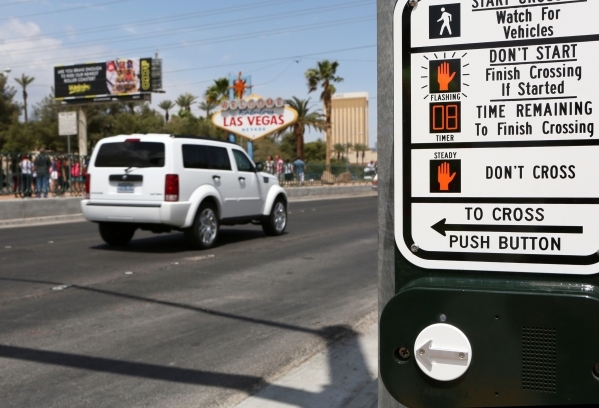Resident concerns often initiate traffic studies

Residents near Buffalo Drive and Badura Avenue have long had concerns about the intersection. Turning left onto Buffalo is impossible according to resident Judy Pleshe.
“You should try it,” she said.
She worries about the safety in the intersection, especially after 19-year-old Alvin Davis Jr. died in a traffic accident there in early September. Though the other driver was arrested for driving under the influence, Pleshe thinks the intersection is hard for anyone to maneuver, impaired or not.
“I’d love to see a light there,” she said.
At the very least, she would like to see Clark County traffic engineers redraw the turning lane to allow more space to accommodate the large construction trucks that use the intersection.
When residents have concerns about traffic issues, the county, Las Vegas, Henderson and North Las Vegas are ready to listen.
Clark County representative Dan Kulin said thanks to resident requests, a traffic study was scheduled for the southwest-area intersection.
“We do about 200 traffic studies a year. We get approximately 250 requests a year,” Kulin said.
He said the difference in those two numbers can be accounted for the fact that many requests are redundant, and frequently, requests come in for traffic issues that have already been studied in the last year or that fall under the jurisdiction of another municipality.
Kulin said studies include counts of pedestrian and vehicle traffic, records of accidents that have happened in the area, an analysis of visibility, vehicle speed, signage and the road’s configuration.
“Generally speaking, when we get a request, it can take two or three months for us to initiate it,” he said. “And then probably another month to evaluate and review.”
Kulin said the outcomes of a study can include leaving things as they are, putting in stop signs or traffic signals or a reconfiguration of traffic.
“We can study an area frequently,” he said. “There are some that we’ll study once a year depending on the requests we receive. As you know, things change in the community all the time.”
Sometimes those changes are rapid. Kulin used the example of Fort Apache Road when the Wet’n’Wild water park was completed. The area quickly went from a rural area to an area that needed traffic lights.
The study process is similar in the city of Las Vegas.
“If we get a request for a traffic signal, we generally complete the study in about one to three months,” said city representative Jace Radke via email. “These types of studies require that we collect and analyze a lot of data (24-hour traffic counts, peak hour turning movement counts, three-year crash data, just to name some of the components).”
Radke said that even after a study shows a traffic signal is warranted, it takes time to secure funding, design the signal and construct it. Traffic signals can cost as much as $500,000.
“Generally speaking, from the time a traffic study shows a signal is warranted to the time the traffic signal is constructed and fully operational can take anywhere from nine months to three years depending on how difficult the signal may be to construct,” he said.
Some signals may require that the municipality secure easements or right-of-way for the pole placement, and others require approval from the Nevada Department of Transportation or from neighboring municipalities when the signal is on a shared border.
A recent example is the Bradley Road and Grand Teton Drive intersection in the northwest. A study was requested in April, completed in June, and construction is set to begin in December, with completion expected in March 2016.
Kulin said in the county, on average, it takes about two years to progress from study request to finished traffic signal, though that timeline changes.
“We rank the planned improvements and do the ones that are needed the most sooner,” he said.
Anyone can request a traffic study. Kulin said while elected officials can bring attention to an area and request a study, requests from the public are just as effective.
To request a study, first determine which municipality is in charge. In North Las Vegas, fill out an online form at tinyurl.com/nlvtraffic. In Las Vegas, requests should be mailed to: Traffic Engineer, City of Las Vegas, 400 Stewart Ave., Las Vegas, NV, 89101. Calls can be made to 702-229-6327. In Clark County, residents can call 702-455-6000.
In Henderson, representative Keith Paul recommends two routes for requests. Residents can call the traffic hotline at 702-267-3200 or visit cityofhenderson.com and select “Contact Henderson” on the bottom center of the page. From there, select “Traffic Engineering” along the left side and then “Submit Request” on the top.
“The most important thing is for them to be as specific as possible,” Paul said, pointing out that the city has a wealth of studies staff can perform from crash and speed studies to pedestrian counts and signal studies.
He said using the Internet submission method is the best because residents can track their requests through the process, or if a similar study has already been completed, they can get information on that study.
— Contact View contributing reporter Ginger Meurer at gmeurer@viewnews.com. Find her on Twitter: @gingermmm.
How to request a traffic studyDetermine which municipality is in charge.
Be as specific as possible in the reason for your request, as there are a wealth of studies that staff can perform, from crash and speed studies to pedestrian counts and signal studies.
In North Las Vegas, fill out an online form at tinyurl.com/nlvtraffic.
In Las Vegas, requests should be mailed to: Traffic Engineer, City of Las Vegas, 400 Stewart Ave., Las Vegas, NV, 89101. Calls can be made to 702-229-6327.
In Clark County, residents can call 702-455-6000.
In Henderson, residents can call the traffic hotline at 702-267-3200 or visit cityofhenderson.com and select “Contact Henderson” on the bottom center of the page. From there, select “Traffic Engineering” along the left side and then “Submit Request” on the top.












